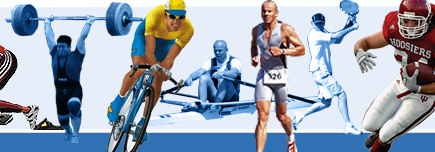KNEE INJURIES
Sprains: Injuries to the ligaments in a joint. The knee has four main stabilizing ligaments, any of which can cause problems if torn.
ACL Injury: The ACL injury is the most common injury to the knee. This ligament prevents the lower leg from moving forward on the upper leg. The mechanism of injury is from a twisting motion when the foot is firmly planted. The degree of severity ranges from a mild stretch of the fibers (Grade I) to complete rupture of the ligament (Grade III). The individual may feel or hear a "pop" with associated swelling. The individual may also report a feeling of "giving out" to the knee, limiting the function of the knee.
MCL Injury: This ligament lies along the inside of the knee and can be damaged by direct trauma from the outside of the knee towards the inside while the foot is planted. The individual may experience pain while walking, climbing stairs, and prolonged sitting. Treatment may include ice, anti-inflammatories, and short-term immobilization to allow the fibers to heal. Rehabilitation may be required to establish range of motion and strength following this injury.
Meniscus Injuries: Commonly called torn cartilage, this is an injury to one of the two circular pads between the upper and lower legs. They function to decrease shock to the knees and distribute weight bearing forces through the legs. The mechanism of injury is a compression force associated with a twisting motion. A "pop" may be heard, but there is usually increased pain along the joint line of the knee. Signs and symptoms include pain, swelling, knee "locking up" or the feeling that the knee is stuck, and difficulty with walking and stairs. If the tear is small enough, the meniscus may heal on its own; however, if pain and decreased function persist, arthroscopic surgery may be required to repair the meniscus.
Osteoarthritis (OA): General degeneration of the knee joint that stems from wear and tear. This is accompanied by gradual increase in pain with activities (walking, stairs, prolonged sitting or standing). Physical therapy will help alleviate the pain by focusing on proper strengthening.
Patello Femoral Pain Syndrome: Categorized as general knee pain that manifests itself near or around the kneecap (patella). This can be caused by an acute injury, muscle imbalances, walking abnormalities, or misalignment of the kneecaps. One or a combination of all of the above can lead to PFPS, causing pain with walking, stairs, squatting, prolonged sitting. Physical therapy can address muscle imbalances and acute symptoms, as well as recommend proper footwear to maximize proper walking mechanics.
|















